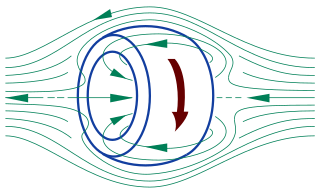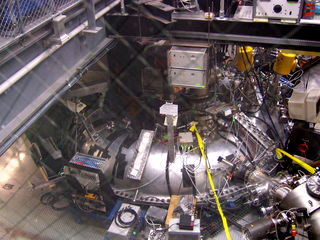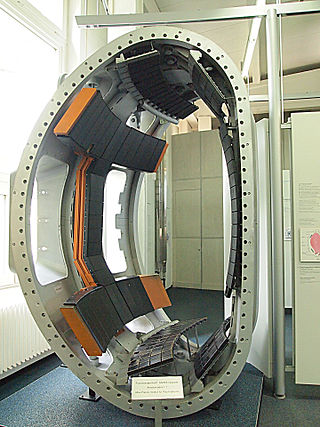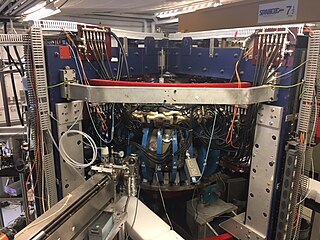Related Research Articles

A tokamak is a device which uses a powerful magnetic field generated by external magnets to confine plasma in the shape of an axially-symmetrical torus. The tokamak is one of several types of magnetic confinement devices being developed to produce controlled thermonuclear fusion power. The tokamak concept is currently one of the leading candidates for a practical fusion reactor.

In plasma physics, plasma stability concerns the stability properties of a plasma in equilibrium and its behavior under small perturbations. The stability of the system determines if the perturbations will grow, oscillate, or be damped out. It is an important consideration in topics such as nuclear fusion and astrophysical plasma.

Fusion power is a proposed form of power generation that would generate electricity by using heat from nuclear fusion reactions. In a fusion process, two lighter atomic nuclei combine to form a heavier nucleus, while releasing energy. Devices designed to harness this energy are known as fusion reactors. Research into fusion reactors began in the 1940s, but as of 2024, no device has reached net power, although net positive reactions have been achieved.

An ion source is a device that creates atomic and molecular ions. Ion sources are used to form ions for mass spectrometers, optical emission spectrometers, particle accelerators, ion implanters and ion engines.
Plasma diagnostics are a pool of methods, instruments, and experimental techniques used to measure properties of a plasma, such as plasma components' density, distribution function over energy (temperature), their spatial profiles and dynamics, which enable to derive plasma parameters.

The Levitated Dipole Experiment (LDX) was an experiment investigating the generation of fusion power using the concept of a levitated dipole. The device was the first of its kind to test the levitated dipole concept and was funded by the US Department of Energy. The machine was also part of a collaboration between the MIT Plasma Science and Fusion Center and Columbia University, where another (non-levitated) dipole experiment, the Collisionless Terrella Experiment (CTX), was located.

Magnetic confinement fusion (MCF) is an approach to generate thermonuclear fusion power that uses magnetic fields to confine fusion fuel in the form of a plasma. Magnetic confinement is one of two major branches of controlled fusion research, along with inertial confinement fusion.

A field-reversed configuration (FRC) is a type of plasma device studied as a means of producing nuclear fusion. It confines a plasma on closed magnetic field lines without a central penetration. In an FRC, the plasma has the form of a self-stable torus, similar to a smoke ring.

The Large Plasma Device is an experimental physics device located at UCLA. It is designed as a general purpose laboratory for experimental plasma physics research. The device began operation in 1991 and was upgraded in 2001 to its current version. The modern LAPD is operated as the primary device for a national collaborative research facility, the Basic Plasma Science Facility, which is supported by the US Department of Energy, Fusion Energy Sciences and the National Science Foundation. Half of the operation time of the device is available to scientists at other institutions and facilities who can compete for time through a yearly solicitation.
The Small Tight Aspect Ratio Tokamak, or START was a nuclear fusion experiment that used magnetic confinement to hold plasma. START was the first full-sized machine to use the spherical tokamak design, which aimed to greatly reduce the aspect ratio of the traditional tokamak design.

The Madison Symmetric Torus (MST) is a reversed field pinch (RFP) physics experiment with applications to both fusion energy research and astrophysical plasmas.

The National Spherical Torus Experiment (NSTX) is a magnetic fusion device based on the spherical tokamak concept. It was constructed by the Princeton Plasma Physics Laboratory (PPPL) in collaboration with the Oak Ridge National Laboratory, Columbia University, and the University of Washington at Seattle. It entered service in 1999. In 2012 it was shut down as part of an upgrade program and became NSTX-U, for Upgrade.
The Enormous Toroidal Plasma Device (ETPD) is an experimental physics device housed at the Basic Plasma Science Facility at University of California, Los Angeles (UCLA). It previously operated as the Electric Tokamak (ET) between 1999 and 2006 and was noted for being the world's largest tokamak before being decommissioned due to the lack of support and funding. The machine was renamed to ETPD in 2009. At present, the machine is undergoing upgrades to be re-purposed into a general laboratory for experimental plasma physics research.

ASDEX Upgrade is a divertor tokamak at the Max-Planck-Institut für Plasmaphysik, Garching that went into operation in 1991. At present, it is Germany's second largest fusion experiment after stellarator Wendelstein 7-X.
Ion cyclotron resonance is a phenomenon related to the movement of ions in a magnetic field. It is used for accelerating ions in a cyclotron, and for measuring the masses of an ionized analyte in mass spectrometry, particularly with Fourier transform ion cyclotron resonance mass spectrometers. It can also be used to follow the kinetics of chemical reactions in a dilute gas mixture, provided these involve charged species.

Plasma is one of four fundamental states of matter characterized by the presence of a significant portion of charged particles in any combination of ions or electrons. It is the most abundant form of ordinary matter in the universe, mostly in stars, but also dominating the rarefied intracluster medium and intergalactic medium. Plasma can be artificially generated, for example, by heating a neutral gas or subjecting it to a strong electromagnetic field.

A ball-pen probe is a modified Langmuir probe used to measure the plasma potential in magnetized plasmas. The ball-pen probe balances the electron and ion saturation currents, so that its floating potential is equal to the plasma potential. Because electrons have a much smaller gyroradius than ions, a moving ceramic shield can be used to screen off an adjustable part of the electron current from the probe collector.

The Hybrid Illinois Device for Research and Applications (HIDRA) is a medium-sized toroidal magnetic fusion device housed in the Nuclear Radiation Laboratory and operated by the Center for Plasma-Material Interactions (CPMI) within the Department of Nuclear, Plasma and Radiological Engineering at the University of Illinois at Urbana–Champaign, United States. HIDRA had its first plasma at the end of April 2016 and started experimental campaigns by December of that year. HIDRA is the former WEGA classical stellarator that was operated at the Max Planck Institute for Plasma Physics in Greifswald Germany from 2001 to 2013.
The Prairie View (PV) Rotamak is a plasma physics experiment at Prairie View A&M University. The experiment studies magnetic plasma confinement to support controlled nuclear fusion experiments. Specifically, the PV Rotamak can be used as either a spherical tokamak or a field-reversed configuration. Some time between 2015 and 2017, most personnel moved on to advanced career opportunities. In 2017, a Final Report to Department of Energy (DOE) was prepared and submitted by Dr. Saganti of PVAMU on the entire research work supported by DOE for 12 years.

The Compact Toroidal Hybrid (CTH) is an experimental device at Auburn University that uses magnetic fields to confine high-temperature plasmas. CTH is a torsatron type of stellarator with an external, continuously wound helical coil that generates the bulk of the magnetic field for containing a plasma.
References
- ↑ Griffith, Sabina. "Pakistan launches national fusion program". ITER Organization. Retrieved 5 January 2013.
- ↑ Hussain, S.; Sadiq, M.; Shah, S. I. W.; Team, GLAST (2015). "Estimation of Electron Temperature on Glass Spherical Tokamak (GLAST)". Journal of Physics: Conference Series. 591 (1): 012009. Bibcode:2015JPhCS.591a2009H. doi: 10.1088/1742-6596/591/1/012009 . ISSN 1742-6596.
- 1 2 3 Hussain, S.; et al. (21 Jan 2016). "Initial Plasma Formation in the GLAST-II Spherical Tokamak". Journal of Fusion Energy. 35 (3): 529–537. doi:10.1007/s10894-015-0052-z. ISSN 0164-0313. S2CID 254642251.
- ↑ Qayyum et al., Time-resolved measurement of plasma parameters by means of triple probe, Review of Scientific Instruments 84, 123502 (2013).
- ↑ Qayyum et al., Triple-probe Diagnostic Measurements in Plasma of GLAST Spherical Tokamak, J Fusion Energ, 35 (2016) 205-213.
- 1 2 Qayyum, A.; Ahmad, S.; Deeba, F.; Hussain, S. (Nov 2016). "Plasma measurements in pulse discharge with resistively heated emissive probe". High Temperature. 54 (6): 802–807. doi:10.1134/s0018151x16060158. ISSN 0018-151X. S2CID 254550304.
- ↑ Hussain, S; Qayyum, A; Ahmad, Z; Ahmad, S; Khan, R; Naveed, M A; Ali, R; Deeba, F; Vorobyov, G M and GLAST Team (20 Jun 2017). "Electrical and optical measurements in the early hydrogen discharge of GLAST-III". Plasma Science and Technology. 19 (8): 085103. Bibcode:2017PlST...19h5103H. doi:10.1088/2058-6272/aa68db. ISSN 1009-0630. S2CID 100202543.
- 1 2 Qayyum, A.; Deeba, Farah; Usman Naseer, M.; Ahmad, S.; Javed, M.A.; Hussain, S. (Sep 2018). "A photodiode array and Langmuir probe for characterizing plasma in GLAST-III tokamak device". Measurement. 125: 56–62. Bibcode:2018Meas..125...56Q. doi:10.1016/j.measurement.2018.04.075. ISSN 0263-2241. S2CID 117336134.
- ↑ Khan, R.; Nazir, M.; Ali, A.; Hussain, S.; Vorobyev, G.M. (Jan 2018). "Development of microwave pre-ionization source for GLAST tokamak". Fusion Engineering and Design. 126: 10–14. Bibcode:2018FusED.126...10K. doi:10.1016/j.fusengdes.2017.11.002. ISSN 0920-3796.
- 1 2 Ahmad, Zahoor; Ahmad, S.; Naveed, M. A.; Deeba, F.; Javeed, M. Aqib; Batool, S.; Hussain, S.; Vorobyov, G. M. (2017). "Optimization of magnetic field system for glass spherical tokamak GLAST-III". Physica Scripta. 92 (4): 045601. Bibcode:2017PhyS...92d5601A. doi:10.1088/1402-4896/aa6458. ISSN 1402-4896. S2CID 125625408.
- 1 2 Ahmad, Zahoor; Ahmad, S.; Deeba, F.; Qayyum, A.; Naveed, M. A.; Khan, R.; Ali, Rafaqat; Javeed, M. Aqib; Ahmed, N.; Hussain, S. (2019). "Start-Up Studies of GLAST-III Spherical Tokamak in the Presence of Poloidal Field". IEEE Transactions on Plasma Science. 47 (2): 4729–4737. Bibcode:2019ITPS...47.4729A. doi:10.1109/TPS.2019.2936265. ISSN 1939-9375. S2CID 203040761.